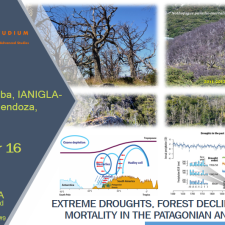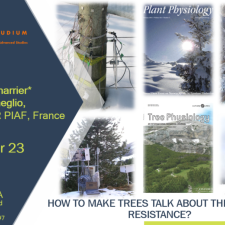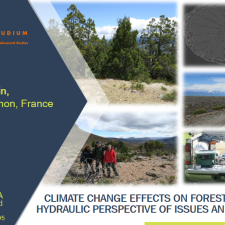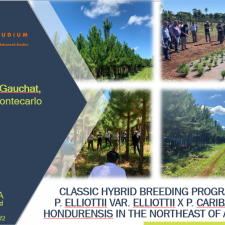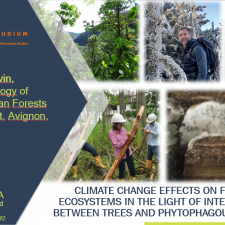Notice
#8 : "Genomic selection for reaction norms on climatic indexes in maritime pine"
- document 1 document 2 document 3
- niveau 1 niveau 2 niveau 3
Descriptif
SEMINAR # 8 : "Genomic selection for reaction norms on climatic indexes in maritime pine"
Léopoldo Sanchez-Rodriguez (INRAE, BioForA, France)
Abstract
A new proof-of-concept study for genomic selection (GS) in maritime pine is presented here with two major steps forward compared to previous case studies of GS in the species: a greater number of informative markers and the focus on wood related phenotypic plasticity traits. The main objective of this study was to combine genomic, phenotypic and environmental data in order to build GS models for norms of reaction (NoR) to climatic indexes.
The GS population is composed of 650 trees from 25 half-sib families established on two contrasted sites (dry vs. humid site) in 1996. These progenies are representative of the second generation of the breeding program of the species in France. The 650 trees were genotyped with the 4TREES Axiom array developed within the B4EST project. Wood related phenotypic records were obtained from X-rayed increment cores collected on all trees, and phenotypes related to each ring (from 1999 to 2019) were extracted, namely: ring width, ring surface, ring density and several other variables describing the within-ring variability.
Two kinds of climatic indexes were used, a classic and simple Martonne aridity index combining temperature and rainfall, and a complex ecophysiological growth model (GO+) able to predict water availability at a very fine scale. The outputs of both models were summarized at annual levels to be used as alternative climatic covariables for ring traits. GS was modelled following different cross-validation scenarios representing operational schemes in the breeding program, and compared to current evaluation system using exclusively pedigree information. Modelling with the climatic indexes as covariables was obtained by a random regression approach, which offered the possibility to predict genetic and genomic breeding value trajectories at individual level over the environmental gradients represented by the sample of years of growth.
Results showed the advantages of GS over the pedigree counterparts in prediction quality over the ranges in the two climatic indexes. The more complex GO+ model provided the best performance overall. Individual trajectories made of breeding values were easily clustered by their shapes over the climatic indexes, with typologies of trajectories showing systematic advantage in growth over the whole range of environments compared to the other less performing NoR typologies. The driest extremes produced less variation among individual trajectories than that observed for the wettest extremes. The wettest range of the cline resulted in large discrimination among individual trajectories. A similar modeling work was done using outputs from a resistograph, with faster a cheaper operational setting.
Results are discussed in the context of breeding of maritime pine facing global changes, with propositions in terms of GS implementation, the strategic use of NoR on climatic indexes, and the choices of partial or cheap phenotyping among candidates to selection.
Intervention / Responsable scientifique
Thème
Dans la même collection
-
#9 Extreme droughts, forest decline and mortality in the Patagonian Andes
SEMINAR # 9 : "Extreme droughts, forest decline and mortality in the Patagonian Andes" Ricardo Villalba (IANIGLA-CONICET, Mendoza, Argentina)
-
#7 « How to make trees talk about their frost resistance? »
CharrierGuillaumeAméglioThierrySEMINAR # 7 : « How to make trees talk about their frost resistance? » Guillaume Charrier (Speaker) and Thierry Ameglio, INRAE, UMR PIAF, France
-
#6 INTEGRATING QUANTITATIVE GENETICS AND GENOMICS WITH FOCUS ON IMPROVING PRODUCTIVITY AND CLIMATE-…
Dr. Eduardo Pablo Cappa, INTA, Argentina SEMINAR # 6 "INTEGRATING QUANTITATIVE GENETICS AND GENOMICS WITH FOCUS ON IMPROVING PRODUCTIVITY AND CLIMATE-ADAPTABILITY TRAITS IN TWO BOREAL CONIFER
-
#5-Climate Change effect on forests : A plant hydraulic perspective of issues and solutions
Martin-St PaulNicolasThe International Associated Laboratory FORESTIA starts in 2022 a new round of short seminars aimed at stimulating the scientific comunication among its members, as well as between them and other
-
#2 CLASSIC HYBRID BREEDING PROGRAM FOR P. ELLIOTTII VAR. ELLIOTTII X P. CARIBAEA VAR. HONDURENSIS I…
Gauchat Funes DrewesMaría ElenaRound of FORESTIA web seminars SEMINAR # 2 "Classic Hybrid Breeding Program for P. elliottii var. elliottii x P. caribaea var. hondurensis in the Northeast of Argentina" María Elena Gauchat,
-
#3 CLIMATE CHANGE EFFECTS ON FOREST ECOSYSTEMS IN THE LIGHT OF INTERACTIONS BETWEEN TREES AND PHYTO…
BoivinThomasRound of FORESTIA web seminars SEMINAR # 3 "Climate change effects on forest ecosystems in the light of interactions between trees and phytophagous insects" Thomas Boivin, INRAE, France May 13
-
#1 "How climate change is challenging forest research" - Pr. Philippe Rozenberg
RozenbergPhilippeLia forestia 2022 Webinaire 1 du 25 mars 2022 par Philippe Rozenberg (INRAE, France) "How climate change is challenging forest research"


